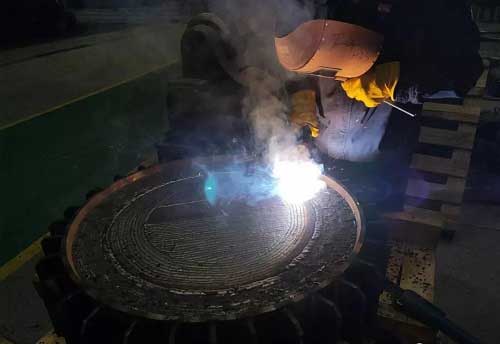Nickel base alloy surfacing (Tech Center of Shanghai HY Industry Co., Ltd)
Shanghai HY Industry Co.,Ltd’s long-term Nickel base alloy surfacing experience and process introduction:
-
 Nickel-based alloys have good properties of resistance to reactive gases, wear-resistant and acid-resistant medium corrosion, and have the characteristics of high strength, good plasticity, hot and cold deformation, processing and welding, and are a very important corrosion-resistant metal material.
Nickel-based alloys have good properties of resistance to reactive gases, wear-resistant and acid-resistant medium corrosion, and have the characteristics of high strength, good plasticity, hot and cold deformation, processing and welding, and are a very important corrosion-resistant metal material. -
In surfacing applications, carbon steel or stainless steel can be surfacing with a layer of nickel-based metal as a dielectric layer, so that it has the advantages of two metals. This type of welding material is completely different from ordinary alloying elements. In welding, different welding methods should be adopted for welding.
-
Due to the different physical properties of metals in surfacing welding, the nickel-based alloy welding pool is very viscous and the melting depth is shallow. Increasing the welding current cannot significantly improve the fluidity of the metal and increase the melting depth.
-
Unlike the concave bead usually formed in stainless steel, the bead surface of nickel-based alloys is markedly convex.
-
In order to prevent crystal cracking, especially the first layer of crystal cracking at the welding root, it can be eliminated by filling the welding metal with a small current.
-
When applying argon arc welding, the welding material should not be directly immersed in the molten pool. The welding material should be placed in front of the tungsten electrode and fed while melting, and the end of the welding material should always be protected by argon gas.
-
 The fluidity of nickel-based welding consumables is poor and the current should not be too large, the welding speed is slow, and the welding should be carefully controlled.
The fluidity of nickel-based welding consumables is poor and the current should not be too large, the welding speed is slow, and the welding should be carefully controlled. -
When welding, whether it is interlayer welding or cover welding, pay attention to argon protection during welding to prevent the welding part from being oxidized.
-
Cold work hardening tendency of different materials is different. For example, the cold work hardening tendency of nickel-based alloys is 1~2 times higher than that of stainless steel. Therefore, if the welding is not controlled, it is easy to bend.
-
Strength of the two dissimilar steels in surfacing welding is different, so pay attention to stress cracking at the root after welding.
-
Nickel-based alloy weld metals do not wet and spread as readily as steel weld metals. Even increasing the welding current does not improve the fluidity of the weld metal, but has a detrimental effect. If the welding current exceeds the recommended range, it will not only overheat the molten pool, increase the sensitivity of hot cracks, and reduce the corrosion resistance due to coarse grains, but also cause the deoxidizer in the weld metal to evaporate, causing pores to appear.
-
In electrode arc welding, the excessive welding current also overheats the electrode and causes the coating to fall off, losing its protective effect. Due to the poor fluidity of the weld metal, it is not easy to flow to both sides of the weld. In order to obtain good weld formation, a wobble process is sometimes used. But this swing is a small swing, and the swing distance does not exceed 3 times the diameter of the welding wire or electrode. Defects are sometimes found in electrode arc welding even with the wobble process.
-
The defects are mainly undercut and unmelted edge. In order to eliminate these defects, when the welding swings to the limit position on each side, it is necessary to pause for a while to allow enough time for the molten weld metal to fully fuse with the base metal, and Fill in the undercut area. Another important process measure to be used in electrode arc welding is that the welding arc should be as short as possible.
-
During the welding process, the inherent characteristics of the electrode nickel-based alloy determine that the penetration of molten iron is shallow, and this problem cannot be solved simply by adjusting the welding parameters.
-
According to repeated tests, the method to overcome the shallow penetration is to modify the traditional groove form, and the angle of the groove position is more suitable between 40 degrees and 65 degrees.
-
 The welding of nickel-based materials has stricter requirements on the surface of the weld than carbon steel and stainless steel. When welding nickel-based materials, it must be welded into a convex bead. The majority of cases of cracking in welding of nickel-based materials are due to uneven force caused by the concave bead.
The welding of nickel-based materials has stricter requirements on the surface of the weld than carbon steel and stainless steel. When welding nickel-based materials, it must be welded into a convex bead. The majority of cases of cracking in welding of nickel-based materials are due to uneven force caused by the concave bead. -
The interlayer temperature in the welding process of nickel-based surfacing materials should not be too high, generally below 100 °C. Welding of nickel-based alloy materials generally does not require preheating and post-heat treatment.

